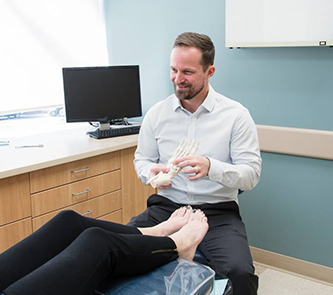Foot & Ankle Fractures and Sprains
Treating Foot & Ankle Fractures and Sprains
For an active person, there’s no worse feeling in the world than a sudden foot or ankle fracture or sprain. One second you’re having a great day. The next? Not so much.
Foot and Ankle Fractures and Sprains are especially common for a couple of reasons. One is that your feet are under a ton of strain whenever you run, jump, change directions, or even just stand and walk. The other is that they’re extremely complex, with more than 50 bones and well over 100 combined muscles, tendons, and ligaments between them—all working together in harmony. In other words, there are a lot of places where things can go wrong!
One thing is for sure: if you do suffer a foot or ankle fracture or sprain, you’ll want to get a full evaluation and treatment recommendations as soon as possible. Even the mildest sprain can be the first step toward lingering instability, arthritis, and re-injury if you don’t let it heal properly. We treat patients from Dover all the way down to Newbury, using effective treatment methods. Reach out to one of our offices located in Portsmouth and Nashua for expert foot and ankle care.

Broken Feet and Toes
A broken bone is never a pleasant experience. But while any potential foot or toe fractures should be brought to the attention of our team as soon as you can, these injuries do vary quite a bit in terms of where and how they are broken, and how severely.
Foot fractures are usually (although not always, especially in the case of stress fractures) the result of a sudden severe trauma, such as twisting, falling, or a direct impact (such as an auto accident, falling off a ladder, dropping a heavy object, etc.). Pain tends to be swift and severe, and may be accompanied by bruising, swelling, and even dislocation or deformity in the shape of the foot if the fracture is unstable.
Common Types of Foot and Ankle Fractures
- Toe and forefoot fractures occur in the front portion of the foot, often involving the long metatarsal bones. Many people mistakenly believe that nothing can be done for these types of fractures, and that there’s no point seeing a doctor unless you’re unable to bear any weight. But nothing could be further from the truth!
- Stress fractures are not “full” breaks, but hairline cracks that form in the surface of bones. Unlike most other sprains and fractures, stress fractures tend to develop slowly over time due to overuse. Stress fractures are common in weight-bearing bones (such as the long metatarsals in the front part of your foot) and can eventually worsen into more severe breaks if you try to keep pushing through the pain.
- Midfoot fractures develop in the area of the arch, where a “clump” of irregularly shaped bones (the tarsals) connect to the long metatarsal bones at the front part of the foot. A severe twist or impact can dislocate or fracture the bones in this region. While this typically makes it too painful to bear weight, some people are able to continue walking on a midfoot fracture—which unfortunately only makes the problem worse.
- Ankle fractures are often sudden and severe, and require immediate medical attention. Unfortunately, many people don’t even realize they have one since the symptoms can overlap with those of a severe sprain. Broken ankles typically need to be casted and often require surgery, so it’s critical to identify and treat them as soon as possible.

Foot and Ankle Sprains
Ankle Sprains
Ankle sprains are, by a considerable margin, the most common traumatic injury related to activity and athletics. They generally occur when a sudden, forceful twisting motion overstretches or tears one or more of the ligaments that hold the ankle joint together.
While a mild (grade 1) sprain might be associated with relatively tolerable pain, swelling, and stiffness, more serious (grade 3) sprains often come with severe pain, instability, and total inability to bear weight.
Keep in mind that even a minor sprain can develop into a major one if you don’t seek care and continue to aggravate the joint! The biggest predictor of future sprains is whether you’ve had sprains in the past. The more sprains you suffer, the more likely that the ligaments will be weaker, looser, and less stable even after they “heal.”
Other Sprains
While the term “sprain” is strongly associated with the ankle joint, it can occur in many places along the foot, including the toes (turf toe) and midfoot (Lisfranc sprain). In each case, ligaments—a type of connective tissue that holds bones to other bones—get stretched, torn, or dislocated and lose their ability to stabilize the bones that attach to them.
Treating Foot and Ankle Fractures and Sprains
Again, it’s important to understand that any potential foot or ankle fracture or sprain should be taken seriously, and at the very least result in a call to our office. If we suspect you only have a mild sprain, we may simply give you some advice for home care and ask you to monitor the situation to see if it improves. If we suspect a more serious injury, we can ask you to come in for a closer look.
In the meantime, immediately discontinue strenuous activities and begin RICE therapy:
- REST—minimize weight bearing.
- ICE—use ice packs (as directed) to limit pain and swelling.
- COMPRESSION—if you know how to properly use a compression wrap, it can help you deal with excess swelling and discomfort.
- ELEVATION—prop your feet up as much as possible.
Further treatment for your sprain or fracture depends greatly on the location and severity of your injury.
Mild-to-moderate sprains, stress fractures, and stable fractures (meaning the bone ends have not shifted position) can often be treated non-surgically. You may need to have your foot or ankle protected or immobilized using a cast, walking boot, or brace to protect and stabilize the area as it heals. There may be a period of total non-weight bearing as well during the early phases of recovery.
More severe injuries may require surgery to repair badly torn ligaments or realign bones that have become unstable, dislocated, or shattered.
While the prospect of working through a few weeks to a few months of recovery isn’t a fun prospect for anyone, ignoring the problem will only make it worse.
Trust Northeast Foot and Ankle for Sprain and Fracture Treatment
For many people, the first instinct after a sprain or fracture to the feet or ankles is to go to the hospital or urgent care.
Certainly, if it is an emergency (as is the case with many severe broken bones, especially those that have broken the skin) we want you to call 911 right away. But in many other cases, it’s often worth calling our office first.
At Northeast Foot & Ankle, our doctors are exclusively focused on caring for the feet and ankles, and have extensive training and specialization in sports-related injuries such as sprains and fractures. This can be an advantage over going to more a “generalist” for your injury care. Plus, same-day and next-day appointments are often available.
Our office is also equipped with advanced non-surgical therapies such as MLS laser and EPAT shockwave, which can be extremely useful in helping our patients recover faster from injuries as well as surgeries.
So if you hurt your feet or ankles, please call us as soon as possible. We’ll carefully evaluate your situation and then help you get the care you need. To reach our offices in Portsmouth or Nashua, NH, call (603) 431-6070 or contact us online today.
Pay Your Bill
Make a payment online through our payment portal or Care Credit!
Portsmouth Office
14 Manchester Square, Suite 250
Portsmouth, NH 03801
Nashua Office
17 Riverside Street, Suite 205
Nashua, NH 03062
Website Hosted by SC Digital



